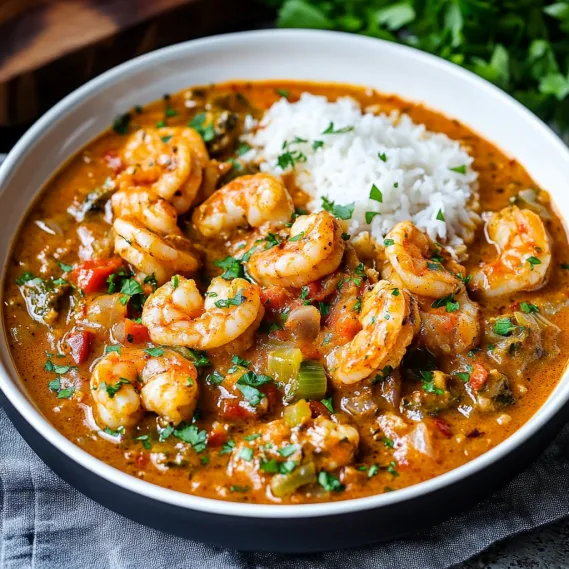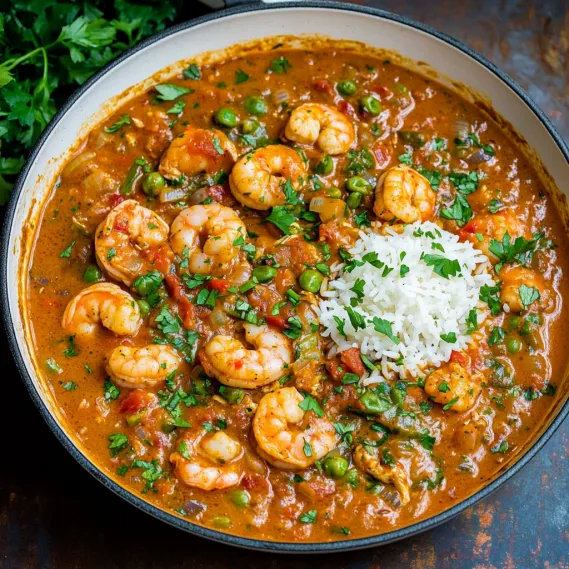 Pin it
Pin it
This hearty Shrimp & Crawfish Étouffée has been my Louisiana kitchen staple for years. The rich, buttery sauce envelops tender seafood for a dish that showcases the best of Creole cooking without requiring professional culinary skills.
I first learned this recipe from my Creole grandmother who insisted proper étouffée was worth the time spent stirring the roux. Now when I make it, the distinctive aroma transports me back to summer evenings on her porch while cicadas sang in the background.
Ingredients
- Crawfish tails: Provide authentic Cajun flavor with their distinctive sweet richness
- Medium shrimp: Offer firm texture and mild seafood flavor that complements the crawfish
- Holy trinity vegetables: Onions, bell peppers, celery form the flavor foundation of Creole cooking
- Vegetable oil and flour: Create the all-important roux that thickens and flavors the dish
- Seafood stock: Enhances the maritime essence – look for high quality or make your own
- Butter: Creates the luxurious mouthfeel that defines étouffée – use unsalted for better control
- Green onions: Add brightness and color to balance the richness
- Fresh parsley: Provides vibrant flavor and visual appeal
- Tony Chachere's Creole Seasoning: Delivers authentic spice blend without measuring multiple ingredients
- Garlic and onion powders: Enhance depth of flavor without overpowering texture
- Italian seasoning: Adds subtle herbal notes that round out the profile
Step-by-Step Instructions
- Prepare The Roux:
- Heat vegetable oil in a heavy skillet until it begins smoking, then carefully whisk in flour until completely combined. Reduce heat to medium and stir constantly for about 15 minutes until the mixture reaches a rich peanut butter color. The roux is the soul of étouffée so watch it carefully and never stop stirring or it will burn.
- Cook The Trinity:
- Turn off heat under the roux and add diced onions, bell peppers, and celery along with seasonings. The residual heat will soften the vegetables without burning them. Stir continuously for about 5 minutes allowing the aromatics to release their flavors into the roux. This step builds the flavor foundation.
- Create The Base Sauce:
- Bring 2 cups of stock to a boil in a separate heavy-bottomed pot, then carefully whisk in the roux mixture until fully dissolved. Reduce heat to medium-low and continue cooking about 10 minutes until the raw flour taste disappears. Season to taste and set aside. The sauce should have the consistency of a thick gravy.
- Prepare The Seafood:
- Clean your skillet and melt one stick of butter over medium heat. Add crawfish tails, shrimp, and green onions, sautéing just until shrimp turn pink, approximately one minute. Be careful not to overcook the seafood as it will continue cooking in the sauce. Add remaining butter and cup of stock, stirring until butter melts completely.
- Combine And Simmer:
- Pour the seafood mixture into the sauce base, whisking to combine all ingredients. Bring to a boil then immediately reduce to a simmer. Cover and cook on low for 30 minutes, stirring occasionally and adjusting seasoning. The extended simmering allows all flavors to meld while keeping the seafood tender.
- Serve With Love:
- Spoon hot étouffée over fluffy white rice and garnish with fresh parsley. The rice serves as the perfect canvas to soak up the rich savory sauce while the parsley adds brightness to each bite.
 Pin it
Pin it
My favorite part of this recipe is the moment when the seafood mixture joins the roux base. The kitchen fills with an aroma that makes everyone gravitate toward the stove asking when dinner will be ready. My grandfather always said you could judge a good étouffée by how quickly people reached for seconds.
Perfect Pairings
Étouffée begs for crusty French bread to soak up every last drop of sauce. For a complete Creole experience, serve with a simple side salad dressed with vinaigrette to cut through the richness. A chilled glass of Sauvignon Blanc or Viognier complements the seafood beautifully, or enjoy with a cold Abita beer for authenticity.
The Roux Matters
The roux is undeniably the most critical component of successful étouffée. Take your time reaching that perfect peanut butter color. Too light and your sauce lacks depth; too dark and bitter notes emerge. Use a wooden spoon with a flat edge to reach the corners of your pan where burning can start. The constant stirring builds arm muscles but results in unparalleled flavor development that forms the backbone of Creole cooking.
Seafood Selection Tips
Fresh seafood makes a dramatic difference in this dish. Look for crawfish tails that are plump with a clean fresh scent. If using frozen, thaw completely and drain thoroughly before adding to avoid watering down your sauce. For shrimp, choose medium size with shells and heads removed but tails intact for presentation. Wild-caught Gulf shrimp offer the sweetest flavor profile but sustainably farmed varieties work well too.
 Pin it
Pin it
Storage And Reheating
Store leftover étouffée in an airtight container in the refrigerator for up to three days. The flavors actually improve overnight as they meld together. Reheat gently over medium-low heat, adding a splash of stock if the sauce has thickened too much. Avoid microwave reheating which can make the seafood tough. Freezing is possible but the texture of the seafood may change slightly upon thawing.
Frequently Asked Questions
- → What is the holy trinity in Creole cooking?
The holy trinity in Creole cooking refers to a mix of diced onions, bell peppers, and celery, which are foundational flavor ingredients in many dishes.
- → Can I use frozen shrimp or crawfish?
Yes, frozen shrimp and crawfish can be used. Be sure to properly thaw and drain them before cooking to avoid excess water in the dish.
- → What can I use as a substitute for Creole seasoning?
If you don’t have Creole seasoning, you can use a blend of garlic powder, onion powder, paprika, cayenne pepper, thyme, oregano, and salt.
- → Can this dish be made ahead of time?
Yes, Shrimp & Crawfish Étouffée can be made ahead. Store it in the refrigerator for up to 3 days and reheat gently on the stovetop before serving.
- → What type of rice pairs best with étouffée?
White rice, such as long-grain or jasmine rice, is typically served with étouffée because it complements the rich and spiced sauce perfectly.
- → How do I prevent the roux from burning?
To prevent the roux from burning, stir constantly over medium heat and reduce the heat if it starts to smoke excessively. Keep it moving to achieve an even, golden brown color.
